SpringMvc介绍
Spring web mvc和Struts2都属于表现层的框架,它是Spring框架的一部分,我们可以从Spring的整体结构中看得出来:
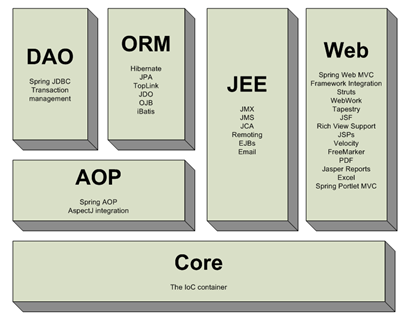
入门程序
开发步骤
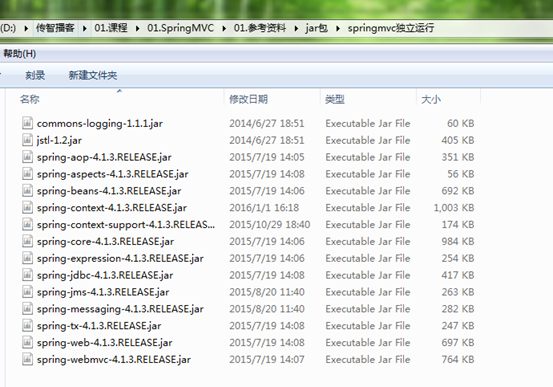
<%@ page language="java" contentType="text/html; charset=UTF-8"
pageEncoding="UTF-8"%>
<%@ taglib uri="http://java.sun.com/jsp/jstl/core" prefix="c" %>
<%@ taglib uri="http://java.sun.com/jsp/jstl/fmt" prefix="fmt"%>
<!DOCTYPE html PUBLIC "-//W3C//DTD HTML 4.01 Transitional//EN" "http://www.w3.org/TR/html4/loose.dtd">
<html>
<head>
<meta http-equiv="Content-Type" content="text/html; charset=UTF-8">
<title>查询商品列表</title>
</head>
<body>
<form action="${pageContext.request.contextPath }/item/queryitem.action" method="post">
查询条件:
<table width="100%" border=1>
<tr>
<td><input type="submit" value="查询"/></td>
</tr>
</table>
商品列表:
<table width="100%" border=1>
<tr>
<td>商品名称</td>
<td>商品价格</td>
<td>生产日期</td>
<td>商品描述</td>
<td>操作</td>
</tr>
<c:forEach items="${itemList }" var="item">
<tr>
<td>${item.name }</td>
<td>${item.price }</td>
<td><fmt:formatDate value="${item.createtime}" pattern="yyyy-MM-dd HH:mm:ss"/></td>
<td>${item.detail }</td>
<td><a href="${pageContext.request.contextPath }/itemEdit.action?id=${item.id}">修改</a></td>
</tr>
</c:forEach>
</table>
</form>
</body>
</html>ItemController是一个普通的java类,不需要实现任何接口,只需要在类上添加@Controller注解即可。@RequestMapping注解指定请求的url,其中“.action”可以加也可以不加。在ModelAndView对象中,将视图设置为“/WEB-INF/jsp/itemList.jsp”
@Controller
publicclass ItemController {
@RequestMapping("/itemList")
public ModelAndView itemList() throws Exception {
List<Items>itemList = new ArrayList<>();
//商品列表
Items items_1 = new Items();
items_1.setName("联想笔记本_3");
items_1.setPrice(6000f);
items_1.setDetail("ThinkPad T430 联想笔记本电脑!");
Items items_2 = new Items();
items_2.setName("苹果手机");
items_2.setPrice(5000f);
items_2.setDetail("iphone6苹果手机!");
itemList.add(items_1);
itemList.add(items_2);
//创建modelandView对象
ModelAndView modelAndView = new ModelAndView();
//添加model
modelAndView.addObject("itemList", itemList);
//添加视图
modelAndView.setViewName("/WEB-INF/jsp/itemList.jsp");
// modelAndView.setViewName("itemsList");
returnmodelAndView;
}
}
商品数据使用Items类描述,可以使用参考资料中提供的pojo类,
第五步:创建SpringMvc.xml
<?xmlversion="1.0"encoding="UTF-8"?>
<beansxmlns="http://www.springframework.org/schema/beans"
xmlns:xsi="http://www.w3.org/2001/XMLSchema-instance"xmlns:p="http://www.springframework.org/schema/p"
xmlns:context="http://www.springframework.org/schema/context"
xmlns:dubbo="http://code.alibabatech.com/schema/dubbo"xmlns:mvc="http://www.springframework.org/schema/mvc"
xsi:schemaLocation="http://www.springframework.org/schema/beans http://www.springframework.org/schema/beans/spring-beans-4.0.xsd
http://www.springframework.org/schema/mvc http://www.springframework.org/schema/mvc/spring-mvc-4.0.xsd
http://code.alibabatech.com/schema/dubbo http://code.alibabatech.com/schema/dubbo/dubbo.xsd
http://www.springframework.org/schema/context http://www.springframework.org/schema/context/spring-context-4.0.xsd">
<context:component-scan base-package="cn.itcast.springmvc.controller"/>
</beans>在web.xml中添加DispatcherServlet的配置。
<!-- 前端控制器 -->
<servlet>
<servlet-name>springmvc</servlet-name>
<servlet-class>org.springframework.web.servlet.DispatcherServlet</servlet-class>
<init-param>
<param-name>contextConfigLocation</param-name>
<param-value>classpath:springmvc.xml</param-value>
</init-param>
</servlet>
<servlet-mapping>
<servlet-name>springmvc</servlet-name>
<url-pattern>*.action</url-pattern>
</servlet-mapping> <servlet-name>springmvc</servlet-name>
<url-pattern>*.action</url-pattern>
</servlet-mapping>SpringMvc架构讲解
框架结构
1、 用户发送请求至前端控制器DispatcherServlet
2、 DispatcherServlet收到请求调用HandlerMapping处理器映射器。
3、 处理器映射器根据请求url找到具体的处理器,生成处理器对象及处理器拦截器(如果有则生成)一并返回给DispatcherServlet。
4、 DispatcherServlet通过HandlerAdapter处理器适配器调用处理器
5、 执行处理器(Controller,也叫后端控制器)。
6、 Controller执行完成返回ModelAndView
7、 HandlerAdapter将controller执行结果ModelAndView返回给DispatcherServlet
8、 DispatcherServlet将ModelAndView传给ViewReslover视图解析器
9、 ViewReslover解析后返回具体View
10、DispatcherServlet对View进行渲染视图(即将模型数据填充至视图中)。
11、 DispatcherServlet响应用户
组件说明
以下组件通常使用框架提供实现:
1 DispatcherServlet:前端控制器
用户请求到达前端控制器,它就相当于mvc模式中的c,dispatcherServlet是整个流程控制的中心,由它调用其它组件处理用户的请求,dispatcherServlet的存在降低了组件之间的耦合性。
2 HandlerMapping:处理器映射器
HandlerMapping负责根据用户请求找到Handler即处理器,springmvc提供了不同的映射器实现不同的映射方式,例如:配置文件方式,实现接口方式,注解方式等。
3 Handler:处理器
Handler 是继DispatcherServlet前端控制器的后端控制器,在DispatcherServlet的控制下Handler对具体的用户请求进行处理。
由于Handler涉及到具体的用户业务请求,所以一般情况需要程序员根据业务需求开发Handler。
4 HandlAdapter:处理器适配器
通过HandlerAdapter对处理器进行执行,这是适配器模式的应用,通过扩展适配器可以对更多类型的处理器进行执行。
5 View Resolver:视图解析器
View Resolver负责将处理结果生成View视图,View Resolver首先根据逻辑视图名解析成物理视图名即具体的页面地址,再生成View视图对象,最后对View进行渲染将处理结果通过页面展示给用户。
6 View:视图
springmvc框架提供了很多的View视图类型的支持,包括:jstlView、freemarkerView、pdfView等。我们最常用的视图就是jsp。
一般情况下需要通过页面标签或页面模版技术将模型数据通过页面展示给用户,需要由程序员根据业务需求开发具体的页面。
| 说明:在springmvc的各个组件中,处理器映射器、处理器适配器、视图解析器称为springmvc的三大组件。 需要用户开放的组件有handler、view |
框架默认加载组件:
注解映射器和适配器:
组件扫描器:
使用组件扫描器省去在spring容器配置每个controller类的繁琐。使用<context:component-scan>自动扫描标记@controller的控制器类,配置如下:
<!-- 扫描controller注解,多个包中间使用半角逗号分隔 -->
<context:component-scanbase-package="cn.itcast.springmvc.controller.first"/>RequestMappingHandlerMapping处理器映射器
注解式处理器映射器,对类中标记@RequestMapping的方法进行映射,根据ResquestMapping定义的url匹配ResquestMapping标记的方法,匹配成功返回HandlerMethod对象给前端控制器,HandlerMethod对象中封装url对应的方法Method。
Srping3.1本开始,废除了DefaultAnnotationHandlerMapping的使用,推荐使用RequestMappingHandlerMapping完成注解式处理器映射。
配置如下:
<!--注解映射器 -->
<beanclass="org.springframework.web.servlet.mvc.method.annotation.RequestMappingHandlerMapping"/>@RequestMapping:定义请求url到处理器功能方法的映射
RequestMappingHandlerAdapter
注解式处理器适配器,对标记@ResquestMapping的方法进行适配。
从spring3.1版本开始,废除了@RequestMapping的使用,推荐使用RequestMappingHandlerAdapter完成注解式处理器适配。
配置如下:
<!--注解适配器 -->
<beanclass="org.springframework.web.servlet.mvc.method.annotation.RequestMappingHandlerAdapter"/>
<mvc:annotation-driven>
springmvc使用<mvc:annotation-driven>自动加载RequestMappingHandlerMapping和RequestMappingHandlerAdapter,可用在springmvc.xml配置文件中使用<mvc:annotation-driven>替代注解处理器和适配器的配置。
试图解析器:在springmvc.xml中配置如下:
<beanclass="org.springframework.web.servlet.view.InternalResourceViewResolver">
<propertyname="viewClass"
value="org.springframework.web.servlet.view.JstlView"/>
<propertyname="prefix"value="/WEB-INF/jsp/"/>
<propertyname="suffix"value=".jsp"/>
</bean>
InternalResourceViewResolver:支持JSP视图解析
viewClass:JstlView表示JSP模板页面需要使用JSTL标签库,所以classpath中必须包含jstl的相关jar 包。此属性可以不设置,默认为JstlView。
prefix 和suffix:查找视图页面的前缀和后缀,最终视图的址为:
前缀+逻辑视图名+后缀,逻辑视图名需要在controller中返回ModelAndView指定,比如逻辑视图名为hello,则最终返回的jsp视图地址 “WEB-INF/jsp/hello.jsp”
SpringMvc整合Mybatis
实现商品查询列表,从mysql数据库查询商品信息。
jar包:
包括:Spring(包括SpringMvc)、mybatis、mybatis-spring整合包、数据库驱动、第三方连接池
参考:mybatis和springmvc整合全部jar包目录
项目搭建:
整合思路:
Dao层:
1、SqlMapConfig.xml,空文件即可。需要文件头。
2、applicationContext-dao.xml。
a) 数据库连接池
b) SqlSessionFactory对象,需要spring和mybatis整合包下的。
c) 配置mapper文件扫描器。
Service层:
1、applicationContext-service.xml包扫描器,扫描@service注解的类。
2、applicationContext-trans.xml配置事务。
表现层:
Springmvc.xml
1、包扫描器,扫描@Controller注解的类。
2、配置注解驱动。
3、视图解析器
Web.xml
配置前端控制器<?xmlversion="1.0"encoding="UTF-8"?>
<!DOCTYPEconfiguration
PUBLIC"-//mybatis.org//DTD Config 3.0//EN"
"http://mybatis.org/dtd/mybatis-3-config.dtd">
<configuration>
</configuration>
<?xmlversion="1.0"encoding="UTF-8"?>
<beansxmlns="http://www.springframework.org/schema/beans"
xmlns:context="http://www.springframework.org/schema/context"xmlns:p="http://www.springframework.org/schema/p"
xmlns:aop="http://www.springframework.org/schema/aop"xmlns:tx="http://www.springframework.org/schema/tx"
xmlns:xsi="http://www.w3.org/2001/XMLSchema-instance"
xsi:schemaLocation="http://www.springframework.org/schema/beans http://www.springframework.org/schema/beans/spring-beans-4.0.xsd
http://www.springframework.org/schema/context http://www.springframework.org/schema/context/spring-context-4.0.xsd
http://www.springframework.org/schema/aop http://www.springframework.org/schema/aop/spring-aop-4.0.xsd http://www.springframework.org/schema/tx http://www.springframework.org/schema/tx/spring-tx-4.0.xsd
http://www.springframework.org/schema/util http://www.springframework.org/schema/util/spring-util-4.0.xsd">
<!-- 加载配置文件 -->
<context:property-placeholderlocation="classpath:db.properties"/>
<!-- 数据库连接池 -->
<beanid="dataSource"class="org.apache.commons.dbcp.BasicDataSource"
destroy-method="close">
<propertyname="driverClassName"value="${jdbc.driver}"/>
<propertyname="url"value="${jdbc.url}"/>
<propertyname="username"value="${jdbc.username}"/>
<propertyname="password"value="${jdbc.password}"/>
<propertyname="maxActive"value="10"/>
<propertyname="maxIdle"value="5"/>
</bean>
<!-- mapper配置 -->
<!-- 让spring管理sqlsessionfactory 使用mybatis和spring整合包中的 -->
<beanid="sqlSessionFactory"class="org.mybatis.spring.SqlSessionFactoryBean">
<!-- 数据库连接池 -->
<propertyname="dataSource"ref="dataSource"/>
<!-- 加载mybatis的全局配置文件 -->
<propertyname="configLocation"value="classpath:mybatis/SqlMapConfig.xml"/>
</bean>
<!-- 配置Mapper扫描器 -->
<beanclass="org.mybatis.spring.mapper.MapperScannerConfigurer">
<propertyname="basePackage"value="cn.itcast.springmvc.mapper"/>
</bean>
</beans>jdbc.driver=com.mysql.jdbc.Driver
jdbc.url=jdbc:mysql://localhost:3306/springmvc?characterEncoding=utf-8
jdbc.username=root
jdbc.password=root
<?xmlversion="1.0"encoding="UTF-8"?>
<beansxmlns="http://www.springframework.org/schema/beans"
xmlns:context="http://www.springframework.org/schema/context"xmlns:p="http://www.springframework.org/schema/p"
xmlns:aop="http://www.springframework.org/schema/aop"xmlns:tx="http://www.springframework.org/schema/tx"
xmlns:xsi="http://www.w3.org/2001/XMLSchema-instance"
xsi:schemaLocation="http://www.springframework.org/schema/beans http://www.springframework.org/schema/beans/spring-beans-4.0.xsd
http://www.springframework.org/schema/context http://www.springframework.org/schema/context/spring-context-4.0.xsd
http://www.springframework.org/schema/aop http://www.springframework.org/schema/aop/spring-aop-4.0.xsd http://www.springframework.org/schema/tx http://www.springframework.org/schema/tx/spring-tx-4.0.xsd
http://www.springframework.org/schema/util http://www.springframework.org/schema/util/spring-util-4.0.xsd">
<context:component-scanbase-package="cn.itcast.springmvc.service"/>
</beans>
<?xmlversion="1.0"encoding="UTF-8"?>
<beansxmlns="http://www.springframework.org/schema/beans"
xmlns:context="http://www.springframework.org/schema/context"xmlns:p="http://www.springframework.org/schema/p"
xmlns:aop="http://www.springframework.org/schema/aop"xmlns:tx="http://www.springframework.org/schema/tx"
xmlns:xsi="http://www.w3.org/2001/XMLSchema-instance"
xsi:schemaLocation="http://www.springframework.org/schema/beans http://www.springframework.org/schema/beans/spring-beans-4.0.xsd
http://www.springframework.org/schema/context http://www.springframework.org/schema/context/spring-context-4.0.xsd
http://www.springframework.org/schema/aop http://www.springframework.org/schema/aop/spring-aop-4.0.xsd http://www.springframework.org/schema/tx http://www.springframework.org/schema/tx/spring-tx-4.0.xsd
http://www.springframework.org/schema/util http://www.springframework.org/schema/util/spring-util-4.0.xsd">
<!-- 事务管理器 -->
<beanid="transactionManager"
class="org.springframework.jdbc.datasource.DataSourceTransactionManager">
<!-- 数据源 -->
<propertyname="dataSource"ref="dataSource"/>
</bean>
<!-- 通知 -->
<tx:adviceid="txAdvice"transaction-manager="transactionManager">
<tx:attributes>
<!-- 传播行为 -->
<tx:methodname="save*"propagation="REQUIRED"/>
<tx:methodname="insert*"propagation="REQUIRED"/>
<tx:methodname="delete*"propagation="REQUIRED"/>
<tx:methodname="update*"propagation="REQUIRED"/>
<tx:methodname="find*"propagation="SUPPORTS"read-only="true"/>
<tx:methodname="get*"propagation="SUPPORTS"read-only="true"/>
</tx:attributes>
</tx:advice>
<!-- 切面 -->
<aop:config>
<aop:advisoradvice-ref="txAdvice"
pointcut="execution(* cn.itcast.springmvc.service.*.*(..))"/>
</aop:config>
</beans>
<?xmlversion="1.0"encoding="UTF-8"?>
<beansxmlns="http://www.springframework.org/schema/beans"
xmlns:xsi="http://www.w3.org/2001/XMLSchema-instance"xmlns:p="http://www.springframework.org/schema/p"
xmlns:context="http://www.springframework.org/schema/context"
xmlns:dubbo="http://code.alibabatech.com/schema/dubbo"xmlns:mvc="http://www.springframework.org/schema/mvc"
xsi:schemaLocation="http://www.springframework.org/schema/beans http://www.springframework.org/schema/beans/spring-beans-4.0.xsd
http://www.springframework.org/schema/mvc http://www.springframework.org/schema/mvc/spring-mvc-4.0.xsd
http://code.alibabatech.com/schema/dubbo http://code.alibabatech.com/schema/dubbo/dubbo.xsd
http://www.springframework.org/schema/context http://www.springframework.org/schema/context/spring-context-4.0.xsd">
<!-- 扫描带Controller注解的类 -->
<context:component-scanbase-package="cn.itcast.springmvc.controller"/>
<!-- 加载注解驱动 -->
<mvc:annotation-driven/>
<!-- 视图解析器 -->
<beanclass="org.springframework.web.servlet.view.InternalResourceViewResolver">
<propertyname="viewClass"
value="org.springframework.web.servlet.view.JstlView"/>
<!-- jsp前缀 -->
<propertyname="prefix"value="/WEB-INF/jsp/"/>
<!-- jsp后缀 -->
<propertyname="suffix"value=".jsp"/>
</bean>
</beans>
<?xmlversion="1.0"encoding="UTF-8"?>
<web-appxmlns:xsi="http://www.w3.org/2001/XMLSchema-instance"
xmlns="http://java.sun.com/xml/ns/javaee"
xsi:schemaLocation="http://java.sun.com/xml/ns/javaee http://java.sun.com/xml/ns/javaee/web-app_2_5.xsd"
id="WebApp_ID"version="2.5">
<display-name>springmvc-web</display-name>
<welcome-file-list>
<welcome-file>index.html</welcome-file>
<welcome-file>index.htm</welcome-file>
<welcome-file>index.jsp</welcome-file>
<welcome-file>default.html</welcome-file>
<welcome-file>default.htm</welcome-file>
<welcome-file>default.jsp</welcome-file>
</welcome-file-list>
<!-- 加载spring容器 -->
<context-param>
<param-name>contextConfigLocation</param-name>
<param-value>classpath:spring/applicationContext-*.xml</param-value>
</context-param>
<listener>
<listener-class>org.springframework.web.context.ContextLoaderListener</listener-class>
</listener>
<servlet>
<servlet-name>springmvc</servlet-name>
<servlet-class>org.springframework.web.servlet.DispatcherServlet</servlet-class>
<init-param>
<param-name>contextConfigLocation</param-name>
<param-value>classpath:spring/springmvc.xml</param-value>
</init-param>
</servlet>
<servlet-mapping>
<servlet-name>springmvc</servlet-name>
<url-pattern>*.action</url-pattern>
</servlet-mapping>
</web-app>
publicinterface ItemService {
List<Items> getItemsList();
}@Service
publicclass ItemServiceImpl implements ItemService {
@Autowired
private ItemMapper itemMapper;
@Override
public List<Items> getItemsList() {
List<Items>itemList = itemMapper.getItemList();
returnitemList;
}
}@Controller
publicclass ItemController {
@Autowired
private ItemService itemService;
@RequestMapping("/itemList")
public ModelAndView getItemList() {
List<Items>list = itemService.getItemsList();
ModelAndView modelAndView = new ModelAndView();
modelAndView.addObject("itemList", list);
modelAndView.setViewName("itemList");
returnmodelAndView;
}
}SpringMVC默认支持类型
简单数据类型:
绑定简单数据类型。
编辑商品信息,需要根据商品id查询商品信息,然后展示到页面。
请求的url:/itemEdit.action
参数:id(商品id)
响应结果:商品编辑页面,展示商品详细信息。
service
@Override
public Items getItemById(intid) {
Items items = itemMapper.getItemById(id);
returnitems;
}
要根据id查询商品数据,需要从请求的参数中把请求的id取出来。Id应该包含在Request对象中。可以从Request对象中取id。
@RequestMapping("/itemEdit")
publicModelAndView itemEdit(HttpServletRequest request) {
//从Request中取id
String strId = request.getParameter("id");
Integer id = null;
//如果id有值则转换成int类型
if (strId != null&& !"".equals(strId)) {
id = newInteger(strId);
} else {
//出错
returnnull;
}
Items items = itemService.getItemById(id);
//创建ModelAndView
ModelAndView modelAndView = new ModelAndView();
//向jsp传递数据
modelAndView.addObject("item", items);
//设置跳转的jsp页面
modelAndView.setViewName("editItem");
returnmodelAndView;
}
默认支持的参数类型:
处理器形参中添加如下类型的参数处理适配器会默认识别并进行赋值。
HttpServletRequest 通过request获取请求信息
HttpServletResponse 通过response处理相应信息
HttpSession 通过session对象得到session中存放的对象
Model/ModelMap ModelMap是Model接口的实现类,通过Model或ModelMap向页面传递数据,如下:
//调用service查询商品信息
Items item = itemService.findItemById(id);
model.addAttribute("item", item);
页面通过${item.XXXX}获取item对象的属性值。
使用Model和ModelMap的效果一样,如果直接使用Model,springmvc会实例化ModelMap
| 如果使用Model则可以不使用ModelAndView对象,Model对象可以向页面传递数据,View对象则可以使用String返回值替代。不管是Model还是ModelAndView,其本质都是使用Request对象向jsp传递数据。 |
@RequestMapping("/itemEdit")
publicString itemEdit(HttpServletRequest request, Model model) {
//从Request中取id
String strId = request.getParameter("id");
Integer id = null;
//如果id有值则转换成int类型
if (strId != null&& !"".equals(strId)) {
id = newInteger(strId);
} else {
//出错
returnnull;
}
Items items = itemService.getItemById(id);
//创建ModelAndView
//ModelAndView modelAndView = new ModelAndView();
//向jsp传递数据
//modelAndView.addObject("item", items);
model.addAttribute("item", items);
//设置跳转的jsp页面
//modelAndView.setViewName("editItem");
//return modelAndView;
return"editItem";
}当请求的参数名称和处理器形参名称一致时会将请求参数与形参进行绑定。从Request取参数的方法可以进一步简化。
@RequestMapping("/itemEdit")
public String itemEdit(Integer id, Model model) {
Items items = itemService.getItemById(id);
//向jsp传递数据
model.addAttribute("item", items);
//设置跳转的jsp页面
return"editItem";
}参数类型推荐使用包装数据类型,因为基础数据类型不可以为null
整形:Integer、int
字符串:String
单精度:Float、float
双精度:Double、double
布尔型:Boolean、boolean
说明:对于布尔类型的参数,请求的参数值为true或false。
处理器方法:
public String editItem(Modelmodel,Integer id,Boolean status) throwsException
请求url:
http://localhost:8080/xxx.action?id=2&status=false
@RequestParam使用@Request常用于处理简单类型的绑定
value:参数名字,即入参的请求参数名字,如value=“item_id”表示请求的参数区中的名字为item_id的参数的值将传入;
required:是否必须,默认是true,表示请求中一定要有相应的参数,否则将报;
TTP Status 400 - Required Integer parameter'XXXX' is not present
defaultValue:默认值,表示如果请求中没有同名参数时的默认值
定义如下:
public String editItem(@RequestParam(value="item_id",required=true) String id) {
}
形参名称为id,但是这里使用value=item_id"限定请求的参数名为item_id,所以页面传递参数的名必须为item_id。
注意:如果请求参数中没有item_id将跑出异常:
HTTP Status 500 - Required Integer parameter'item_id' is not present
这里通过required=true限定item_id参数为必需传递,如果不传递则报400错误,可以使用defaultvalue设置默认值,即使required=true也可以不传item_id参数值
绑定pojo类型pojo类型
将页面修改后的商品信息保存到数据库中。
需求分析:请求的url:/updateitem.action
参数:表单中的数据。
响应内容:更新成功页面
使用pojo接收表单数据如果提交的参数很多,或者提交的表单中的内容很多的时候可以使用pojo接收数据。要求pojo对象中的属性名和表单中input的name属性一致。
页面定义如下:<input type="text" name="name"/>
<input type="text" name="price"/>import java.util.Date;
public class Items{
private Integer id;
private String name;
private Float price;
private String pic;
private Date createtime;
}请求的参数名称和pojo的属性名称一致,会自动将请求参数赋值给pojo的属性。
@RequestMapping("/updateitem")
public String updateItem(Items items) {
itemService.updateItem(items);
return"success";
}
| 注意:提交的表单中不要有日期类型的数据,否则会报400错误。如果想提交日期类型的数据需要用到后面的自定义参数绑定的内容。 |
<filter>
<filter-name>CharacterEncodingFilter</filter-name>
<filter-class>org.springframework.web.filter.CharacterEncodingFilter</filter-class>
<init-param>
<param-name>encoding</param-name>
<param-value>utf-8</param-value>
</init-param>
</filter>
<filter-mapping>
<filter-name>CharacterEncodingFilter</filter-name>
<url-pattern>/*</url-pattern>
</filter-mapping>
以上可以解决post请求乱码问题。
对于get请求中文参数出现乱码解决方法有两个:
修改tomcat配置文件添加编码与工程编码一致,如下:
<Connector URIEncoding="utf-8" connectionTimeout="20000" port="8080" protocol="HTTP/1.1" redirectPort="8443"/>String userName new
String(request.getParamter("userName").getBytes("ISO8859-1"),"utf-8")
ISO8859-1是tomcat默认编码,需要将tomcat编码后的内容按utf-8编码
pojo包装类型
<input type="text" name="items.name" />
<input type="text" name="items.price" />public String useraddsubmit(Model model,QueryVoqueryVo)throws Exception{
System.out.println(queryVo.getItems());@RequestMapping("/queryitem")
public String queryItem(QueryVo queryVo) {
System.out.println(queryVo.getItems().getName());
System.out.println(queryVo.getItems().getPrice());
returnnull;
}自定义参数绑定类型
在商品修改页面可以修改商品的生产日期,并且根据业务需求自定义日期格式。
需求分析:publicclass DateConverter implements Converter<String, Date> {
@Override
public Date convert(String source) {
SimpleDateFormat simpleDateFormat = new SimpleDateFormat("yyyy-MM-dd HH:mm:ss");
try {
returnsimpleDateFormat.parse(source);
} catch (ParseException e) {
e.printStackTrace();
}
returnnull;
}
} <!-- 加载注解驱动 -->
<mvc:annotation-drivenconversion-service="conversionService"/>
<!-- 转换器配置 -->
<beanid="conversionService"
class="org.springframework.format.support.FormattingConversionServiceFactoryBean">
<propertyname="converters">
<set>
<beanclass="cn.itcast.springmvc.convert.DateConverter"/>
</set>
</property>
</bean><?xmlversion="1.0"encoding="UTF-8"?>
<beansxmlns="http://www.springframework.org/schema/beans"
xmlns:xsi="http://www.w3.org/2001/XMLSchema-instance"xmlns:p="http://www.springframework.org/schema/p"
xmlns:context="http://www.springframework.org/schema/context"
xmlns:dubbo="http://code.alibabatech.com/schema/dubbo"xmlns:mvc="http://www.springframework.org/schema/mvc"
xsi:schemaLocation="http://www.springframework.org/schema/beans http://www.springframework.org/schema/beans/spring-beans-4.0.xsd
http://www.springframework.org/schema/mvc http://www.springframework.org/schema/mvc/spring-mvc-4.0.xsd
http://code.alibabatech.com/schema/dubbo http://code.alibabatech.com/schema/dubbo/dubbo.xsd
http://www.springframework.org/schema/context http://www.springframework.org/schema/context/spring-context-4.0.xsd">
<!-- 扫描带Controller注解的类 -->
<context:component-scanbase-package="cn.itcast.springmvc.controller"/>
<!-- 转换器配置 -->
<beanid="conversionService"
class="org.springframework.format.support.FormattingConversionServiceFactoryBean">
<propertyname="converters">
<set>
<beanclass="cn.itcast.springmvc.convert.DateConverter"/>
</set>
</property>
</bean>
<!-- 自定义webBinder -->
<beanid="customBinder" class="org.springframework.web.bind.support.ConfigurableWebBindingInitializer">
<propertyname="conversionService"ref="conversionService"/>
</bean>
<!--注解适配器 -->
<beanclass="org.springframework.web.servlet.mvc.method.annotation.RequestMappingHandlerAdapter">
<propertyname="webBindingInitializer"ref="customBinder"></property>
</bean>
<!-- 注解处理器映射器 -->
<beanclass="org.springframework.web.servlet.mvc.method.annotation.RequestMappingHandlerMapping"/>
<!-- 加载注解驱动 -->
<!-- <mvc:annotation-driven/> -->
<!-- 视图解析器 -->
<beanclass="org.springframework.web.servlet.view.InternalResourceViewResolver">
<propertyname="viewClass"
value="org.springframework.web.servlet.view.JstlView"/>
<!-- jsp前缀 -->
<propertyname="prefix"value="/WEB-INF/jsp/"/>
<!-- jsp后缀 -->
<propertyname="suffix"value=".jsp"/>
</bean>
</beans>
注意:此方法需要独立配置处理器映射器、适配器,不再使用<mvc:annotation-driven/>
SpringMvc和Struts2的区别
1、 springmvc的入口是一个servlet即前端控制器,而struts2入口是一个filter过虑器。
2、springmvc是基于方法开发(一个url对应一个方法),请求参数传递到方法的形参,可以设计为单例或多例(建议单例),struts2是基于类开发,传递参数是通过类的属性,只能设计为多例。
3、 Struts采用值栈存储请求和响应的数据,通过OGNL存取数据, springmvc通过参数解析器是将request请求内容解析,并给方法形参赋值,将数据和视图封装成ModelAndView对象,最后又将ModelAndView中的模型数据通过reques域传输到页面。Jsp视图解析器默认使用jstl。
高级参数绑定
数组类型的参数绑定
此功能要求商品列表页面中的每个商品前有一个checkbook,选中多个商品后点击删除按钮把商品id传递给Controller,根据商品id删除商品信息。
jsp中实现:<c:forEach items="${itemList }" var="item">
<tr>
<td><input name="ids" value="${item.id}" type="checkbox"></td>
<td>${item.name }</td>
<td>${item.price }</td>
<td><fmt:formatDate value="${item.createtime}" pattern="yyyy-MM-dd HH:mm:ss"/></td>
<td>${item.detail }</td>
<td><a href="${pageContext.request.contextPath }/itemEdit.action?id=${item.id}">修改</a></td>
</tr>
</c:forEach><table width="100%" border=1>
<tr>
<td>商品名称</td>
<td>商品价格</td>
<td>生产日期</td>
<td>商品描述</td>
<td>操作</td>
</tr>
<tr>
<td><input name="ids" value="1" type="checkbox"></td>
<td>台式机</td>
<td>3000.0</td>
<td>2016-02-03 13:22:53</td>
<td></td>
<td><a href="/springmvc-web/itemEdit.action?id=1">修改</a></td>
</tr>
<tr>
<td><input name="ids" value="2" type="checkbox"></td>
<td>笔记本</td>
<td>6000.0</td>
<td>2015-02-09 13:22:57</td>
<td></td>
<td><a href="/springmvc-web/itemEdit.action?id=2">修改</a></td>
</tr>
<tr>
<td><input name="ids" value="3" type="checkbox"></td>
<td>背包</td>
<td>200.0</td>
<td>2015-02-06 13:23:02</td>
<td></td>
<td><a href="/springmvc-web/itemEdit.action?id=3">修改</a></td>
</tr>
</table>Controller方法中可以用String[]接收,或者pojo的String[]属性接收。两种方式任选其一即可。
定义如下:
@RequestMapping("/queryitem")
public String queryItem(QueryVo queryVo, String[] ids) {
System.out.println(queryVo.getItems().getName());
System.out.println(queryVo.getItems().getPrice());
System.out.println(ids.toString());
return null;
}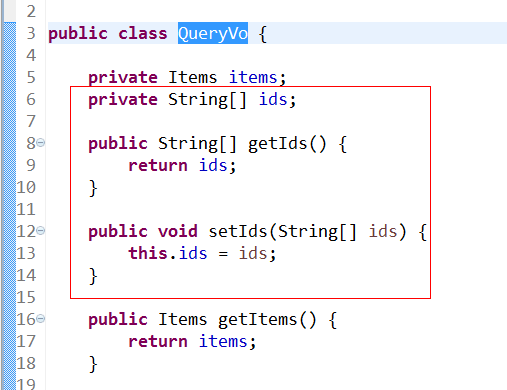
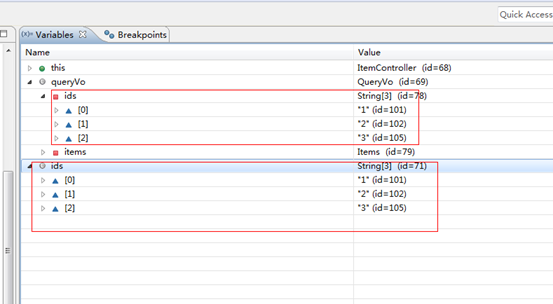
list类型的绑定
要想实现商品数据的批量修改,需要在商品列表中可以对商品信息进行修改,并且可以批量提交修改后的商品数据。
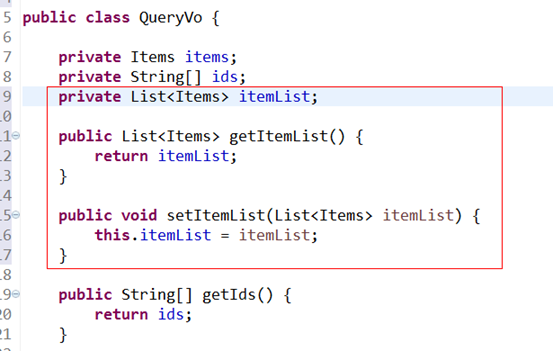
<tr>
<td>
<input type="text" name=" itemsList[0].id" value="${item.id}"/>
</td>
<td>
<input type="text" name=" itemsList[0].name" value="${item.name }"/>
</td>
<td>
<input type="text" name=" itemsList[0].price" value="${item.price}"/>
</td>
</tr>
<tr>
<td>
<input type="text" name=" itemsList[1].id" value="${item.id}"/>
</td>
<td>
<input type="text" name=" itemsList[1].name" value="${item.name }"/>
</td>
<td>
<input type="text" name=" itemsList[1].price" value="${item.price}"/>
</td>
</tr>
Name属性必须是包装pojo的list属性+下标+元素属性。Jsp做如下改造:
<c:forEach items="${itemList }" var="item" varStatus="status">
<tr>
<!-- name属性名称要等于vo中的接收的属性名 -->
<!-- 如果批量删除,可以用List<pojo>来接收,页面上input框的name属性值= vo中接收的集合属性名称+[list的下标]+.+list泛型的属性名称 -->
<td>
<input type="checkbox" name="ids" value="${item.id }"/>
<input type="hidden" name="itemsList[${status.index }].id" value="${item.id }"/>
</td>
<td><input type="text" name="itemsList[${status.index }].name" value="${item.name }"/></td>
<td><input type="text" name="itemsList[${status.index }].price" value="${item.price }"/></td>
<td><input type="text" name="itemsList[${status.index }].createtime"
value="<fmt:formatDate value="${item.createtime}" pattern="yyyy-MM-dd HH:mm:ss"/>"/></td>
<td><input type="text" name="itemsList[${status.index }].detail" value="${item.detail }"/></td>
<td><a href="${pageContext.request.contextPath }/items/itemEdit/${item.id}">修改</a></td>
</tr>
</c:forEach>
| varStatus属性常用参数总结下: ${status.index} 输出行号,从0开始。 ${status.count} 输出行号,从1开始。 ${status.current} 当前这次迭代的(集合中的)项 ${status.first} 判断当前项是否为集合中的第一项,返回值为true或false ${status.last} 判断当前项是否为集合中的最后一项,返回值为true或false begin、end、step分别表示:起始序号,结束序号,跳跃步伐。 |
@RequestMapping("/queryitem")
public String queryItem(QueryVo queryVo, String[] ids) {
System.out.println(queryVo.getItems().getName());
System.out.println(queryVo.getItems().getPrice());
System.out.println(ids.toString());
return null;
}
注意:接收List类型的数据必须是pojo的属性,方法的形参为List类型无法正确接收到数据。
@RequestMapping注解的使用
url路径映射
@RequestMapping(value="/item")或@RequestMapping("/item)
value的值是数组,可以将多个url映射到同一个方法
窄化请求映射:
@RequestMapping放在类名上边,设置请求前缀
@Controller
@RequestMapping("/item")
方法名上边设置请求映射url:
@RequestMapping放在方法名上边,如下:
@RequestMapping("/queryItem ")
访问地址为:/item/queryItem
请求方法限定:
@RequestMapping(method = RequestMethod.GET)
如果通过Post访问则报错:
HTTP Status 405 - Request method 'POST' notsupported
例如:
@RequestMapping(value="/editItem",method=RequestMethod.GET)
@RequestMapping(method = RequestMethod.POST)
如果通过Post访问则报错:
HTTP Status 405 - Request method 'GET' notsupported
GET和POST都可以
@RequestMapping(method={RequestMethod.GET,RequestMethod.POST})
Controller方法返回值
在controller方法形参上可以定义request和response,使用request或response指定响应结果:
1、使用request转向页面,如下:request.getRequestDispatcher("页面路径").forward(request, response);
2、也可以通过response页面重定向:response.sendRedirect("url")
3、也可以通过response指定响应结果,例如响应json数据如下:
response.setCharacterEncoding("utf-8");
response.setContentType("application/json;charset=utf-8");
response.getWriter().write("json串");
controller方法返回字符串可以指定逻辑视图名,通过视图解析器解析为物理视图地址。
//指定逻辑视图名,经过视图解析器解析为jsp物理路径:/WEB-INF/jsp/item/editItem.jsp
return "item/editItem";Contrller方法返回结果重定向到一个url地址,如下商品修改提交后重定向到商品查询方法,参数无法带到商品查询方法中。
//重定向到queryItem.action地址,request无法带过去
return "redirect:queryItem.action";
redirect方式相当于“response.sendRedirect()”,转发后浏览器的地址栏变为转发后的地址,因为转发即执行了一个新的request和response。
由于新发起一个request原来的参数在转发时就不能传递到下一个url,如果要传参数可以/item/queryItem.action后边加参数,如下:
/item/queryItem?...&…..
controller方法执行后继续执行另一个controller方法,如下商品修改提交后转向到商品修改页面,修改商品的id参数可以带到商品修改方法中。
//结果转发到editItem.action,request可以带过去
return "forward:editItem.action";
forward方式相当于“request.getRequestDispatcher().forward(request,response)”,转发后浏览器地址栏还是原来的地址。转发并没有执行新的request和response,而是和转发前的请求共用一个request和response。所以转发前请求的参数在转发后仍然可以读取到。
SpringMvc中异常处理
系统中异常包括两类:预期异常和运行时异常RuntimeException,前者通过捕获异常从而获取异常信息,后者主要通过规范代码开发、测试通过手段减少运行时异常的发生。
系统的dao、service、controller出现都通过throwsException向上抛出,最后由springmvc前端控制器交由异常处理器进行异常处理,如下图:
自定义异常:为了区别不同的异常通常根据异常类型自定义异常类,这里我们创建一个自定义系统异常,如果controller、service、dao抛出此类异常说明是系统预期处理的异常信息。
public class CustomException extends Exception {
/** serialVersionUID*/
private static final long serialVersionUID = -5212079010855161498L;
public CustomException(String message){
super(message);
this.message = message;
}
//异常信息
private String message;
public String getMessage() {
return message;
}
public void setMessage(String message) {
this.message = message;
}
}public class CustomExceptionResolver implements HandlerExceptionResolver {
@Override
public ModelAndView resolveException(HttpServletRequest request,
HttpServletResponse response, Object handler, Exception ex) {
ex.printStackTrace();
CustomException customException = null;
//如果抛出的是系统自定义异常则直接转换
if(ex instanceof CustomException){
customException = (CustomException)ex;
}else{
//如果抛出的不是系统自定义异常则重新构造一个系统错误异常。
customException = new CustomException("系统错误,请与系统管理 员联系!");
}
ModelAndView modelAndView = new ModelAndView();
modelAndView.addObject("message", customException.getMessage());
modelAndView.setViewName("error");
return modelAndView;
}
} try {
} catch (Exception e) {
StringWriter s = new StringWriter();
PrintWriter printWriter = new PrintWriter(s);
e.printStackTrace(printWriter);
s.toString();
}<%@ page language="java" contentType="text/html; charset=UTF-8"
pageEncoding="UTF-8"%>
<%@ taglib uri="http://java.sun.com/jsp/jstl/core" prefix="c" %>
<%@ taglib uri="http://java.sun.com/jsp/jstl/fmt" prefix="fmt"%>
<!DOCTYPE html PUBLIC "-//W3C//DTD HTML 4.01 Transitional//EN" "http://www.w3.org/TR/html4/loose.dtd">
<html>
<head>
<meta http-equiv="Content-Type" content="text/html; charset=UTF-8">
<title>错误页面</title>
</head>
<body>
您的操作出现错误如下:<br/>
${message }
</body>
</html><!-- 异常处理器 -->
<bean id="handlerExceptionResolver" class="cn.itcast.ssm.controller.exceptionResolver.CustomExceptionResolver"/>// 调用service查询商品信息
Items item = itemService.findItemById(id);
if(item == null){
throw new CustomException("商品信息不存在!");
}图片上传处理
在tomcat上配置图片虚拟目录,在tomcat下conf/server.xml中添加:
<Context docBase="F:\develop\upload\temp"path="/pic" reloadable="false"/>
访问http://localhost:8080/pic即可访问F:\develop\upload\temp下的图片。
也可以通过eclipse配置:

<!-- 文件上传 -->
<bean id="multipartResolver"
class="org.springframework.web.multipart.commons.CommonsMultipartResolver">
<!-- 设置上传文件的最大尺寸为5MB -->
<property name="maxUploadSize">
<value>5242880</value>
</property>
</bean>//商品修改提交
@RequestMapping("/editItemSubmit")
public String editItemSubmit(Items items, MultipartFile pictureFile)throws Exception{
//原始文件名称
String pictureFile_name = pictureFile.getOriginalFilename();
//新文件名称
String newFileName = UUID.randomUUID().toString()+pictureFile_name.substring(pictureFile_name.lastIndexOf("."));
//上传图片
File uploadPic = new java.io.File("F:/develop/upload/temp/"+newFileName);
if(!uploadPic.exists()){
uploadPic.mkdirs();
}
//向磁盘写文件
pictureFile.transferTo(uploadPic);
.....form添加enctype="multipart/form-data":
<form id="itemForm"
action="${pageContext.request.contextPath }/item/editItemSubmit.action"
method="post" enctype="multipart/form-data">
<input type="hidden" name="pic" value="${item.pic }" />
file的name与controller形参一致:
<tr>
<td>商品图片</td>
<td><c:if test="${item.pic !=null}">
<img src="/pic/${item.pic}" width=100 height=100 />
<br />
</c:if> <input type="file" name="pictureFile" /></td>
</tr>
json数据交互
@RequestBody
作用:
@RequestBody注解用于读取http请求的内容(字符串),通过springmvc提供的HttpMessageConverter接口将读到的内容转换为json、xml等格式的数据并绑定到controller方法的参数上。
List.action?id=1&name=zhangsan&age=12
本例子应用:
@RequestBody注解实现接收http请求的json数据,将json数据转换为java对象
@ResponseBody
作用:
该注解用于将Controller的方法返回的对象,通过HttpMessageConverter接口转换为指定格式的数据如:json,xml等,通过Response响应给客户端
本例子应用:
@ResponseBody注解实现将controller方法返回对象转换为json响应给客户端
请求json,相应json实现:
环境准备:
Springmvc默认用MappingJacksonHttpMessageConverter对json数据进行转换,需要加入jackson的包,如下:
jackson-core-asl-1.9.11.jarjackson-mapper-asl-1.9.11.jar
配置json转换器:
在注解适配器中加入messageConverters
<!--注解适配器 -->
<bean class="org.springframework.web.servlet.mvc.method.annotation.RequestMappingHandlerAdapter">
<property name="messageConverters">
<list>
<bean class="org.springframework.http.converter.json.MappingJacksonHttpMessageConverter"></bean>
</list>
</property>
</bean>注意:如果使用<mvc:annotation-driven /> 则不用定义上边的内容。
controller编写:// 商品修改提交json信息,响应json信息
@RequestMapping("/editItemSubmit_RequestJson")
public @ResponseBody Items editItemSubmit_RequestJson(@RequestBody Items items) throws Exception {
System.out.println(items);
//itemService.saveItem(items);
return items;
}引入 js:
<script type="text/javascript"
src="${pageContext.request.contextPath}/js/jquery-1.4.4.min.js"></script>
//请求json响应json
function request_json(){
$.ajax({
type:"post",
url:"${pageContext.request.contextPath }/item/editItemSubmit_RequestJson.action",
contentType:"application/json;charset=utf-8",
data:'{"name":"测试商品","price":99.9}',
success:function(data){
alert(data);
}
});
}
从上图可以看出请求的数据是json格式
SpringMvc实现Restful
Restful就是一个资源定位及资源操作的风格。不是标准也不是协议,只是一种风格,是对http协议的诠释。
资源定位:互联网所有的事物都是资源,要求url中没有动词,只有名词。没有参数
Url格式:http://blog.csdn.net/beat_the_world/article/details/45621673
资源操作:使用put、delete、post、get,使用不同方法对资源进行操作。分别对应添加、删除、修改、查询。一般使用时还是post和get。Put和Delete几乎不使用。
需求:<servlet>
<servlet-name>springmvc-servlet-rest</servlet-name>
<servlet-class>org.springframework.web.servlet.DispatcherServlet</servlet-class>
<init-param>
<param-name>contextConfigLocation</param-name>
<param-value>classpath:spring/springmvc.xml</param-value>
</init-param>
</servlet>
<servlet-mapping>
<servlet-name>springmvc-servlet-rest</servlet-name>
<url-pattern>/</url-pattern>
</servlet-mapping>@RequestMapping(value="/viewItems/{id}"):{×××}占位符,请求的URL可以是“/viewItems/1”或“/viewItems/2”,通过在方法中使用@PathVariable获取{×××}中的×××变量。
@PathVariable用于将请求URL中的模板变量映射到功能处理方法的参数上。
@RequestMapping("/viewItems/{id}")
public @ResponseBody viewItems(@PathVariable("id") String id,Model model) throws Exception{
//方法中使用@PathVariable获取useried的值,使用model传回页面
//调用 service查询商品信息
ItemsCustom itemsCustom = itemsService.findItemsById(id);
return itemsCustom;
}
如果RequestMapping中表示为"/viewItems/{id}",id和形参名称一致,@PathVariable不用指定名称。
商品查询的controller方法也改为rest实现:
// 查询商品列表
@RequestMapping("/queryItem")
public ModelAndView queryItem() throws Exception {
// 商品列表
List<Items> itemsList = itemService.findItemsList(null);
// 创建modelAndView准备填充数据、设置视图
ModelAndView modelAndView = new ModelAndView();
// 填充数据
modelAndView.addObject("itemsList", itemsList);
// 视图
modelAndView.setViewName("item/itemsList");
return modelAndView;
}如果在DispatcherServlet中设置url-pattern为 /则必须对静态资源进行访问处理。
spring mvc 的<mvc:resources mapping="" location="">实现对静态资源进行映射访问。
如下是对js文件访问配置:
<mvc:resources location="/js/"mapping="/js/**"/>
拦截器
Public class HandlerInterceptor1 implements HandlerInterceptor{
/**
* controller执行前调用此方法
* 返回true表示继续执行,返回false中止执行
* 这里可以加入登录校验、权限拦截等
*/
@Override
Public boolean preHandle(HttpServletRequest request,
HttpServletResponse response, Object handler) throws Exception {
// TODO Auto-generated method stub
Return false;
}
/**
* controller执行后但未返回视图前调用此方法
* 这里可在返回用户前对模型数据进行加工处理,比如这里加入公用信息以便页面显示
*/
@Override
Public void postHandle(HttpServletRequest request,
HttpServletResponse response, Object handler,
ModelAndView modelAndView) throws Exception {
// TODO Auto-generated method stub
}
/**
* controller执行后且视图返回后调用此方法
* 这里可得到执行controller时的异常信息
* 这里可记录操作日志,资源清理等
*/
@Override
Public void afterCompletion(HttpServletRequest request,
HttpServletResponse response, Object handler, Exception ex)
throws Exception {
// TODO Auto-generated method stub
}
}<bean
class="org.springframework.web.servlet.handler.BeanNameUrlHandlerMapping">
<property name="interceptors">
<list>
<ref bean="handlerInterceptor1"/>
<ref bean="handlerInterceptor2"/>
</list>
</property>
</bean>
<bean id="handlerInterceptor1" class="springmvc.intercapter.HandlerInterceptor1"/>
<bean id="handlerInterceptor2" class="springmvc.intercapter.HandlerInterceptor2"/><!--拦截器 -->
<mvc:interceptors>
<!--多个拦截器,顺序执行 -->
<mvc:interceptor>
<mvc:mapping path="/**"/>
<bean class="cn.itcast.springmvc.filter.HandlerInterceptor1"></bean>
</mvc:interceptor>
<mvc:interceptor>
<mvc:mapping path="/**"/>
<bean class="cn.itcast.springmvc.filter.HandlerInterceptor2"></bean>
</mvc:interceptor>
</mvc:interceptors>定义两个拦截器分别为:HandlerInterceptor1和HandlerInteptor2,每个拦截器的preHandler方法都返回true。
@Overeride
public boolean preHandle(HttpServletRequest request,HttpServletResponse response,Pbject handler)throws Exception{
System.out.println("HandlerIntercepter1....PreHandle");
return true;
}运行流程
HandlerInterceptor1..preHandle..
HandlerInterceptor2..preHandle..
HandlerInterceptor2..postHandle..
HandlerInterceptor1..postHandle..
HandlerInterceptor2..afterCompletion..
HandlerInterceptor1..afterCompletion..
中断流程测试:定义两个拦截器分别为:HandlerInterceptor1和HandlerInteptor2。
运行流程:HandlerInterceptor1的preHandler方法返回false,HandlerInterceptor2返回true,运行流程如下:
HandlerInterceptor1..preHandle..
从日志看出第一个拦截器的preHandler方法返回false后第一个拦截器只执行了preHandler方法,其它两个方法没有执行,第二个拦截器的所有方法不执行,且controller也不执行了。
HandlerInterceptor1的preHandler方法返回true,HandlerInterceptor2返回false,运行流程如下:
HandlerInterceptor1..preHandle..
HandlerInterceptor2..preHandle..
HandlerInterceptor1..afterCompletion..
从日志看出第二个拦截器的preHandler方法返回false后第一个拦截器的postHandler没有执行,第二个拦截器的postHandler和afterCompletion没有执行,且controller也不执行了。
总结:
preHandle按拦截器定义顺序调用
postHandler按拦截器定义逆序调用
afterCompletion按拦截器定义逆序调用
postHandler在拦截器链内所有拦截器返成功调用
afterCompletion只有preHandle返回true才调用
拦截器应用:1、有一个登录页面,需要写一个controller访问页面
2、登录页面有一提交表单的动作。需要在controller中处理。
a) 判断用户名密码是否正确
b) 如果正确 想session中写入用户信息
c) 返回登录成功,或者跳转到商品列表
3、拦截器。
a)拦截用户请求,判断用户是否登录
b)如果用户已经登录。放行
c) 如果用户未登录,跳转到登录页面。
用户身份认证:Public class LoginInterceptor implements HandlerInterceptor{
@Override
Public boolean preHandle(HttpServletRequest request,
HttpServletResponse response, Object handler) throws Exception {
//如果是登录页面则放行
if(request.getRequestURI().indexOf("login.action")>=0){
return true;
}
HttpSession session = request.getSession();
//如果用户已登录也放行
if(session.getAttribute("user")!=null){
return true;
}
//用户没有登录挑战到登录页面
request.getRequestDispatcher("/WEB-INF/jsp/login.jsp").forward(request, response);
return false;
}
}//登陆页面
@RequestMapping("/login")
public String login(Model model)throws Exception{
return "login";
}
//登陆提交
//userid:用户账号,pwd:密码
@RequestMapping("/loginsubmit")
public String loginsubmit(HttpSession session,String userid,String pwd)throws Exception{
//向session记录用户身份信息
session.setAttribute("activeUser", userid);
return "redirect:item/queryItem.action";
}
//退出
@RequestMapping("/logout")
public String logout(HttpSession session)throws Exception{
//session过期
session.invalidate();
return "redirect:item/queryItem.action";
}









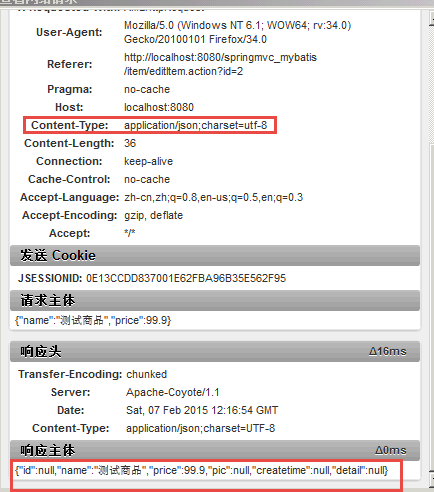














 307
307

 被折叠的 条评论
为什么被折叠?
被折叠的 条评论
为什么被折叠?








